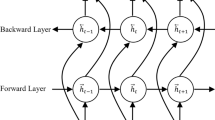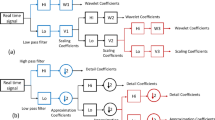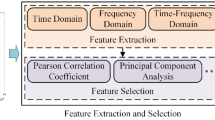Abstract
Accurate tool wear prediction is crucial for preventive maintenance on time. Most of the existing data-driven prediction methods still need complex feature engineering, which reduces the prediction accuracy and efficiency. To address this problem, a tool wear prediction model based on Improved Particle Swarm Optimization (IPSO) Convolutional Neural Network (CNN) and Bidirectional long short-term memory (BiLSTM) network is proposed. Firstly, the cutting force, vibration, and acoustic emission signals are taken as the input features of the model. CNN is used for high-dimensional feature extraction in the raw signal. Then, the BiLSTM with long-term memory and time-series processing ability is used to model time-series data. Besides, IPSO is employed to enhance the prediction accuracy of the hybrid model. Finally, the fully connected layer obtains the tool wear prediction results. IEEE PHM 2010 challenge data was used to illustrate and validate this model. The experimental results show that the hybrid model has an average prediction error of 7.06% on this data set, with an average absolute error (MAE) and an average root mean square error (RMSE) of 1.49 and 1.81, respectively. The prediction performance of the proposed hybrid model outperforms other related deep learning models.













Similar content being viewed by others
Data availability
The acquisition website of these data sets is provided in this study.
Code availability
It declares that codes are not available for this research.
References
Sun HB, Zhang JD, Mo R, Zhang XZ (2020) In-process tool condition forecasting based on a deep learning method. Robot Comput Integr Manuf 64:101924. https://doi.org/10.1016/j.rcim.2019.101924
Ma JY, Luo DC, Liao XP, Zhang ZK, Huang Y, Lu J (2021) Tool wear mechanism and prediction in milling TC18 titanium alloy using deep learning. Measurement 173:108554. https://doi.org/10.1016/j.measurement.2020.108554
Najafi B, Hakim H (1992) A comparative study of non-parametric spectral estimators for application in machine vibration analysis. Mech Syst Signal Process 6(6):551–574. https://doi.org/10.1016/0888-3270(92)90049-O
MikoIajczyk T, Nowicki K, Bustillo A, Pimenov DY (2018) Predicting tool life in turning operations using neural networks and image processing. Mech Syst Signal Process 104:503–513. https://doi.org/10.1016/j.ymssp.2017.11.022
Zhang CJ, Yao XF, Zhang JM, Jin H (2016) Tool condition monitoring and remaining useful life prognostic based on a wireless sensor in dry milling operations. Sensors 16(6):795. https://doi.org/10.3390/s16060795
Zhou JJ, Yu JB (2021) Chisel edge wear measurement of high-speed steel twist drills based on machine vision. Comput Ind 128:103436. https://doi.org/10.1016/j.compind.2021.103436
Atli A, Urhan O, Ertürk S, Sönmez M (2006) A computer vision-based fast approach to drilling tool condition monitoring. Proc Inst Mech Eng Part B: J Eng Manuf 220(9):1409–1415. https://doi.org/10.1243/09544054JEM412
Xu YW, Gui L, Xie TC (2021) Intelligent recognition method of turning tool wear state based on information fusion technology and BP neural network. Shock Vib 2021. https://doi.org/10.1155/2021/7610884
Gomes MC, Brito LC, Da Silva MB, Duarte MAV (2021) Tool wear monitoring in micromilling using support vector machine with vibration and sound sensors. Precis Eng 67:137–151. https://doi.org/10.1016/j.precisioneng.2020.09.025
Wu DZ, Jennings C, Terpenny J, Gao RX, Kumara S (2017) A comparative study on machine learning algorithms for smart manufacturing: tool wear prediction using random forests. J Manuf Sci Eng 139(7). https://doi.org/10.1115/1.4036350
Wang MW, Zhou JT, Gao J, Li ZQ, Li EM (2020) Milling tool wear prediction method based on deep learning under variable working conditions. IEEE Access 8:140726–140735. https://doi.org/10.1109/ACCESS.2020.3010378
Hinton G, Salakhutdinov R (2006) Reducing the dimensionality of data with neural networks. Sci 313(5786):504–507. https://doi.org/10.1126/science.1127647
Xu XW, Wang JW, Ming WW, Chen M, An QL (2021) In-process tap tool wear monitoring and prediction using a novel model based on deep learning. Int J Adv Manuf Technol 112(1):453–466. https://doi.org/10.1007/s00170-020-06354-y
Cao XC, Chen BQ, Yao B, He WP (2019) Combining translation-invariant wavelet frames and convolutional neural network for intelligent tool wear state identification. Comput Ind 106:71–84. https://doi.org/10.1016/j.compind.2018.12.018
Cai WL, Zhang WJ, Hu XF, Liu YC (2020) A hybrid information model based on long short-term memory network for tool condition monitoring. J Intell Manuf 31(6):1497–1510. https://doi.org/10.1007/s10845-019-01526-4
Liu CF, Zhu LD (2020) A two-stage approach for predicting the remaining useful life of tools using bidirectional long short-term memory. Measurement 64:108029. https://doi.org/10.1016/j.measurement.2020.108029
Nasir V, Sassani F (2021) A review on deep learning in machining and tool monitoring: methods, opportunities, and challenges. Int J Adv Manuf Technol 115(9):2683–2709. https://doi.org/10.1007/s00170-021-07325-7
Zhang XY, Lu X, Li WD, Wang S (2021) Prediction of the remaining useful life of cutting tool using the Hurst exponent and CNN-LSTM. Int J Adv Manuf Technol 112(7):2277–2299. https://doi.org/10.1007/s00170-020-06447-8
An QL, Tao ZR, Xu XW, El Mansori M, Chen M (2020) A data-driven model for milling tool remaining useful life prediction with convolutional and stacked LSTM network. Measurement 154:107461. https://doi.org/10.1016/j.measurement.2019.107461
Singh P, Chaudhury S, Panigrahi BK (2021) Hybrid MPSO-CNN: multi-level particle swarm optimized hyperparameters of convolutional neural network. Swarm Evolut Comput 63:100863. https://doi.org/10.1016/j.swevo.2021.100863
Wang YL, Zhang HX, Zhang GW (2019) cPSO-CNN: an efficient PSO-based algorithm for fine-tuning hyper-parameters of convolutional neural networks. Swarm Evolut Comput 49:114–123. https://doi.org/10.1016/j.swevo.2019.06.002
Wang JJ, Ma YL, Zhang LB, Gao RX, Wu DZ (2018) Deep learning for smart manufacturing: methods and applications. Manuf Syst 48:144–156. https://doi.org/10.1016/j.jmsy.2018.01.003
Ren XQ, Liu SL, Yu XD, Xia D (2021) A method for state-of-charge estimation of lithium-ion batteries based on PSO-LSTM. Energy 234:121236. https://doi.org/10.1016/j.energy.2021.121236
Sinha T, Haidar A, Verma B (2018) Particle swarm optimization based approach for finding optimal values of convolutional neural network parameters. IEEE Proc Congr Evol Comput 1-6. https://doi.org/10.1109/CEC.2018.8477728
Kim TY, Cho SB (2021) Optimizing CNN-LSTM neural networks with PSO for anomalous query access control. Neurocomputing 456:666–677. https://doi.org/10.1016/j.neucom.2020.07.154
Kara A (2021) A data-driven approach based on deep neural networks for lithium-ion battery prognostics. Neural Comput Appl 33(20):13525–13538. https://doi.org/10.1007/s00521-021-05976-x
LeCun Y, Boser B, Denker JS, Henderson D, Howard RE, Hubbard W, Jackel LD (1989) Handwritten digit recognition with a back-propagation network. Adv Neural Inf Process Syst 2 https://dl.acm.org/doi/abs/https://doi.org/10.5555/2969830.2969879
Chen HY, Lee CH (2021) Deep learning approach for vibration signals applications. Sensors 21(11):3929. https://doi.org/10.3390/s21113929
Hong CW, Lee K, Ko MS, Kim JK, Oh K, Hur K (2020) Multivariate time series forecasting for remaining useful life of turbofan engine using deep-stacked neural network and correlation analysis. IEEE Int Conf Big Data Smart Comput 63-70. https://doi.org/10.1109/BigComp48618.2020.00-98
Wu CZ, Jiang PC, Ding C, Feng FZ, Chen T (2019) Intelligent fault diagnosis of rotating machinery based on one-dimensional convolutional neural network. Comput Ind 108:53–61. https://doi.org/10.1016/j.compind.2018.12.001
Hochreiter S, Schmidhuber J (1997) Long short-term memory. Neural Comput 9(8):1735–1780. https://doi.org/10.1162/neco.1997.9.8.1735
Kennedy J, Eberhart R (1995) Particle swarm optimization. IEEE Proc Int Conf Neural Netw 4:1942–1948. https://doi.org/10.1109/ICNN.1995.488968
Zhao HL, Han GY, Niu XF (2020) The signal control optimization of road intersections with slow traffic based on improved PSO. Mobile Netw Appl 25(2):623–631. https://doi.org/10.1007/s11036-019-01225-7
Ding HJ, Gu XS (2020) Hybrid of human learning optimization algorithm and particle swarm optimization algorithm with scheduling strategies for the flexible job-shop scheduling problem. Neurocomputing 414:313–332. https://doi.org/10.1016/j.neucom.2020.07.004
Kim TY, Cho SB (2019) Particle swarm optimization-based CNN-LSTM networks for forecasting energy consumption. IEEE Proc Congr Evol Comput 1510-1516. https://doi.org/10.1109/CEC.2019.8789968
Li X, Lim BS, Zhou JH, Huang S, Phua SJ, Shaw KC, Er MJ (2009) Fuzzy neural network modelling for tool wear estimation in dry milling operation. Annual Conference of the PHM Society 1(1). Available at: http://www.papers.phmsociety.org/index.php/phmconf/article/view/1403. Accessed 17 Nov 2022
Wang JJ, Yan JX, Li C, Gao RX, Zhao R (2019) Deep heterogeneous GRU model for predictive analytics in smart manufacturing: application to tool wear prediction. Comput Ind 111:1–14. https://doi.org/10.1016/j.compind.2019.06.001
Xu XW, Wang JW, Zhong BF, Ming WW, Chen M (2021) Deep learning-based tool wear prediction and its application for machining process using multi-scale feature fusion and channel attention mechanism. Measurement 177:109254. https://doi.org/10.1016/j.measurement.2021.109254
Funding
This study was supported by Guangxi Key Laboratory of Manufacturing System and Advanced Manufacturing Technology (Grant No.19–050-44-S006).
Author information
Authors and Affiliations
Contributions
XL: supervision, project administration, funding acquisition, writing—review and editing. XQ: methodology, experiment, software, writing—original draft. JW: validation, investigation. JY: data curation. ZH: visualization.
Corresponding author
Ethics declarations
Ethics approval
The authors claim that there are no ethical issues involved in this research.
Consent to participate
All the authors consent to participate in this research and contribute to the research.
Consent for publication
All the authors consent to publish the research. There are no potential copyrightagiarism issues involved in this research.
Competing interests
The authors declare no competing interests.
Additional information
Publisher's note
Springer Nature remains neutral with regard to jurisdictional claims in published maps and institutional affiliations.
Rights and permissions
Springer Nature or its licensor (e.g. a society or other partner) holds exclusive rights to this article under a publishing agreement with the author(s) or other rightsholder(s); author self-archiving of the accepted manuscript version of this article is solely governed by the terms of such publishing agreement and applicable law.
About this article
Cite this article
Li, X., Qin, X., Wu, J. et al. Tool wear prediction based on convolutional bidirectional LSTM model with improved particle swarm optimization. Int J Adv Manuf Technol 123, 4025–4039 (2022). https://doi.org/10.1007/s00170-022-10455-1
Received:
Accepted:
Published:
Issue Date:
DOI: https://doi.org/10.1007/s00170-022-10455-1




